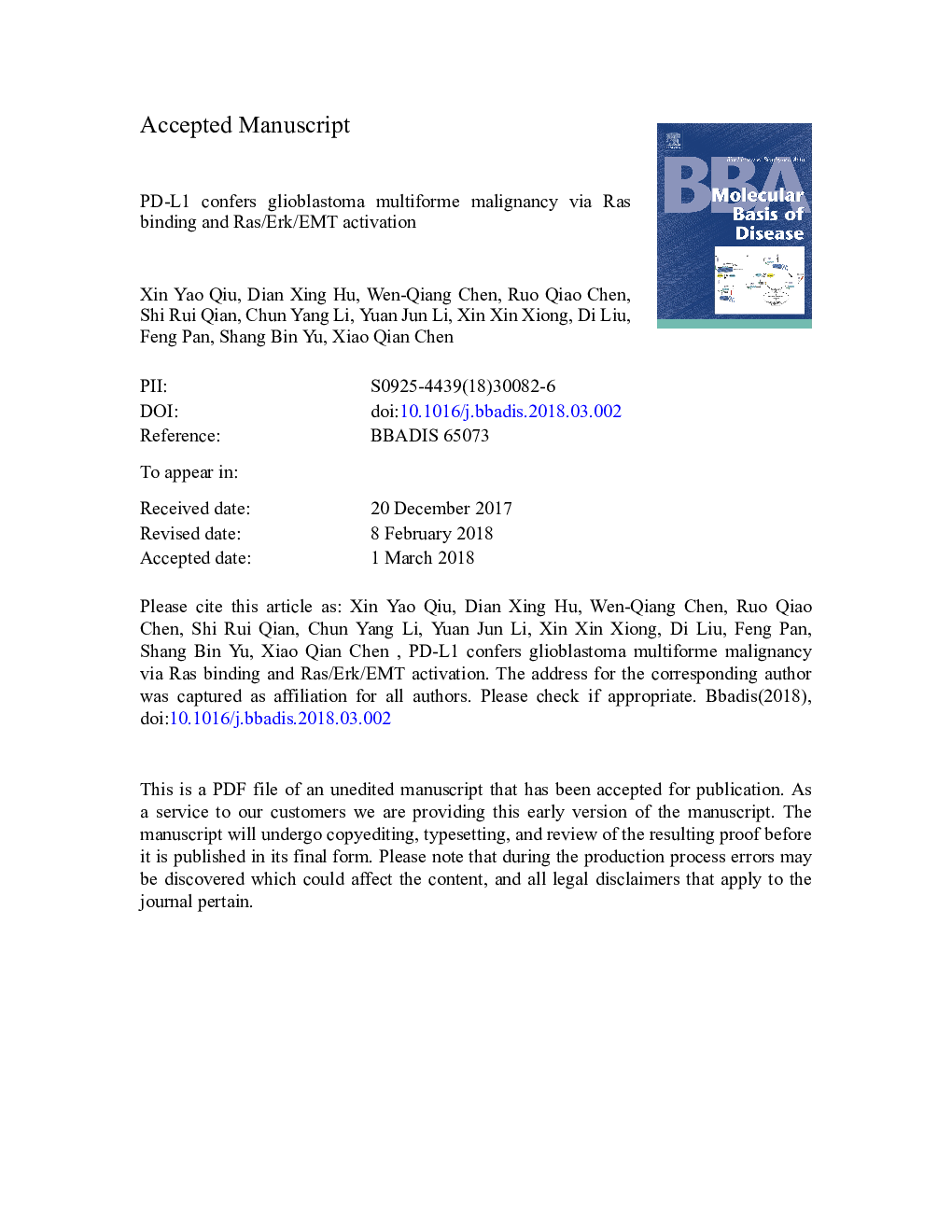| Article ID | Journal | Published Year | Pages | File Type |
|---|---|---|---|---|
| 8258476 | Biochimica et Biophysica Acta (BBA) - Molecular Basis of Disease | 2018 | 56 Pages |
Abstract
Glioblastoma multiforme (GBM) is the most aggressive primary brain tumor due to the lack of effective therapeutic drugs. Cancer therapy targeting programmed cell death protein 1 (PD-1) or programmed death ligand-1 (PD-L1) is of revolutionary. However, the role of intrinsic PD-L1, which determines immune-therapy outcomes, remains largely unclear. Here we demonstrated an oncogenic role of PD-L1 via binding and activating Ras in GBM cells. RNA-sequencing transcriptome data revealed that PD-L1 significantly altered gene expression enriched in cell growth/migration/invasion pathways in human GBM cells. PD-L1 overexpression and knockout or knockdown demonstrated that PD-L1 promoted GBM cell proliferation and migration in vitro and in vivo. Mechanistically, PD-L1 prominently activated epithelial mesenchymal transition (EMT) process in a MEK/Erk- but not PI3K/Akt-dependent manner. Further, we identified intracellular interactions of PD-L1 and H-Ras, which led to Ras/Erk/EMT activation. Finally, we demonstrated that PD-L1 overexpression promoted while knockdown abolished GBM development and invasion in orthotopic GBM models of rodents. Taken together, we found that intracellular PD-L1 confers GBM cell malignancy and aggressiveness via binding Ras and activating the downstream Erk-EMT signaling. Thus, these results shed important insights in improving efficacy of immune therapy for GBM as well as other malignant tumors.
Keywords
PI3K3-(4, 5-dimethylthiazol-2-yl)-2,5-diphenyltetrazolium bromideImage-Pro Plus5-Ethynyl-2-deoxyuridineB7-H1HIFVimentinGSK3GBMPFAIPPRBDDEGsGSTshRNAeGFPGFPPD-L1CTLPBSPD-1DMEMFBSBSACRISPR/CasEdUH&EMAPKDulbecco's modified Eagle's mediumMTTPhosphatidylinositol-4,5-bisphosphate 3-kinasesingle guide RNAshort hairpin RNAsgRNAbovine serum albuminSprague-Dawleyepithelial mesenchymal transitionImmunohistochemistryIHCbioluminescence imagingProtein-protein interactionBrain tumorEMTBLIRAS-binding domainKEGG یا Kyoto Encyclopedia of Genes and Genomes Kyoto Encyclopedia of Genes and Genomesfetal bovine serumHypoxia-inducible factorphosphate buffer salineCytotoxic T lymphocytesProgrammed death ligand-1Gene ontologyhematoxylin-eosinLentivirusparaformaldehydegreen fluorescent proteinenhanced green fluorescent proteinprogrammed cell death protein 1mitogen-activated protein kinaseDifferently expressed genesglutathione S-transferaseGlioblastoma multiformeglycogen synthase kinase 3
Related Topics
Life Sciences
Biochemistry, Genetics and Molecular Biology
Ageing
Authors
Xin Yao Qiu, Dian Xing Hu, Wen-Qiang Chen, Ruo Qiao Chen, Shi Rui Qian, Chun Yang Li, Yuan Jun Li, Xin Xin Xiong, Di Liu, Feng Pan, Shang Bin Yu, Xiao Qian Chen,
